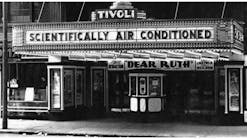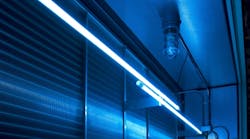As air-conditioning equipment ages, its ability to maintain adequate space temperatures and humidity levels declines.1,2,3 Often, the culprit is reduced coil heat-transfer effectiveness, or the ability of air-handling-unit (AHU) cooling coils to remove heat from air. Evidence shows this drop in performance can occur within five years of startup.
Typically, reduced heat-transfer effectiveness results from the buildup of contaminants on coil surfaces. This accumulation of organic material causes higher leaving-air wet-bulb temperature, meaning an AHU is removing less water from air and, as a result, space humidity is elevated. Additionally, coil pressure drop is higher and, with constant-volume fans, airflow is reduced.
Of course, there also are energy and other cost penalties associated with coil buildup, as fouled chilled-water systems use more energy to compensate for lost capacity and system-management time is increased.
System-capacity consequences can be seen in the ASHRAE equation:
Btu = cfm × 4.5 × (h1 − h2)
where:
h1 − h2 = enthalpy difference in British thermal units per degree wet bulb
Here, it can be seen that capacity decreases with airflow and coil enthalpy differences, and even small changes can have a dramatic effect on cooling capability. Therefore, both airflow and coil temperature differential must remain at “as-built” conditions for a system to perform as designed.
Equipment manufacturers usually recommend coil cleaning twice and no less than once a year to prevent capacity loss. With staffs and budgets shrinking, however, time and/or money for in-house or contracted coil cleaning is becoming scarce. In fact, some building operators report they have not cleaned their coils in three to four years or more. If coil cleaning is not performed regularly, contaminant buildup on interior surfaces can become so difficult to remove that expensive coil replacement becomes the only option.
UV-C Light Prevents Buildup
Performance losses from contaminant buildup have led many building operators to retrofit their air-conditioning systems with ultraviolet-C (UV-C) light systems. ASHRAE Handbook—HVAC Applications4 suggests UV-C reduces mold and biofilm, coil pressure drop, and coil-cleaning functions without the use of chemicals. Further, it states use of UV-C can increase airflow and heat-transfer coefficient and reduce both fan- and refrigeration-system energy use. Savings of 10 to 30 percent have been reported once capacity is restored.
Even relatively low levels of UV-C irradiance can be effective.4,5 The numbers suggest about 8 watts per square foot of coil surface area, which equates to 0.016 watt per cubic foot per minute, is effective for both surface and airborne kill.
Many HVAC manufacturers are offering UV technology as an option or as standard equipment, believing UV-C can contribute to maintenance of as-built capacity for the life of a system.
Users of UV-C technology report occupant complaints are down6,7 and there is no need to purchase coil-cleaning chemicals and drain-pan tabs and perform the time-consuming maintenance functions associated with them.4 Most have embarked on significant energy-saving initiatives because they are confident their newly restored capacity is sustainable.
UV-C Is a Green Technology
UV-C has many of the features consumers expect from a green product:
• UV-C is energy-efficient (energy in vs. work out).8 The average installation uses far less than 1 percent of the power used to run an air-conditioning system. Considering the potential power saved, surplus energy of 10 to 30 percent may be available to harvest and more.
• UV-C contributes to healthy indoor air.7 ASHRAE Handbook—HVAC Applications4 recognizes the indoor-air-quality benefits of coil-irradiation installations, which, in addition to microorganisms in coils and drain pans, kill airborne infectious microbes, lowering the incidence of colds and flu.3,9 A 360-degree UV-C installation also disinfects interior plenum surfaces and, sometimes, air filters.
• By reducing or eliminating coil cleaning, UV-C decreases the use and disposal of water and harsh chemicals.2,4
Retrofits to the Rescue
UV-C is effective for new-construction and existing-building projects. Contractors and users report retrofits are relatively simple to perform. Reported installation costs of 15 cents per cubic foot per minute and less are lower than the cost of a properly performed coil-cleaning procedure,1 especially when system shutdowns, off-hour work, and associated labor costs are considered.
Conclusion
With today’s buildings having elevated expectations related to comfort, energy, and return on investment and with staff and budget issues increasingly a concern, UV-C, with its many benefits, may deserve a harder look.
References
1) Blatt, M.S., Okura, T., & Meister, B. (2006, March). Ultraviolet light for coil cleaning in schools. Engineered Systems, pp. 50-61.
2) Montgomery, R.D., & Baker, R. (2006, November). Study verifies coil cleaning saves energy. ASHRAE Journal, pp. 34-36.
3) RLW Analytics. (2006). Advanced HVAC systems for improving indoor environmental quality and energy performance of California K-12 schools, project 3 final report: UVC technology. Sacramento, CA: California Energy Commission. Available at http://www.archenergy.com/ieq-k12/Public/Proj3_Deliverables/D3.0e_UVCFinalReport_2006-0629.pdf
4) ASHRAE. (2011). ASHRAE handbook—HVAC applications (ch. 60.8). Atlanta: ASHRAE.
5) Kowalski, W. (2009). Ultraviolet germicidal irradiation handbook: UVGI for air and surface disinfection. Berlin: Springer-Verlag.
6) Levetin, E., Shaughnessy, R., Rogers, C.A., & Scheir, R. (2001). Effectiveness of germicidal UV radiation for reducing fungal contamination within air handling units. Applied and Environmental Microbiology, 67, 3712-3715.
7) Menzies, D., Popa, J., Hanley, J.A., Rand, T., & Milton, D.K. (2003). Effect of ultraviolet germicidal lights installed in office ventilation systems on workers’ health and well being: Double-blind multiple crossover trial. Lancet, 363, 1785-1792.
8) Rea, M. (Ed.). (2000). IESNA lighting handbook (9th ed.). New York: Illuminating Engineering Society of North America.
9) Scheir, R., & Fencl, F.B. (1996, February). Using UVC technology to enhance IAQ. Heating/Piping/AirConditioning, pp. 109–123.
SIDEBAR: UV-C Lighting Systems
A UV-C lighting system typically consists of fixtures, lamps, and door interlock switches, as well as a source of power. Options can include a radiometer or a lamp-monitoring kit for local and remote monitoring. For retrofits, some manufacturers offer framing kits to hold fixtures inside coil plenums, although most users build their own.
Did you find this article useful? Send comments and suggestions to Executive Editor Scott Arnold at [email protected].










